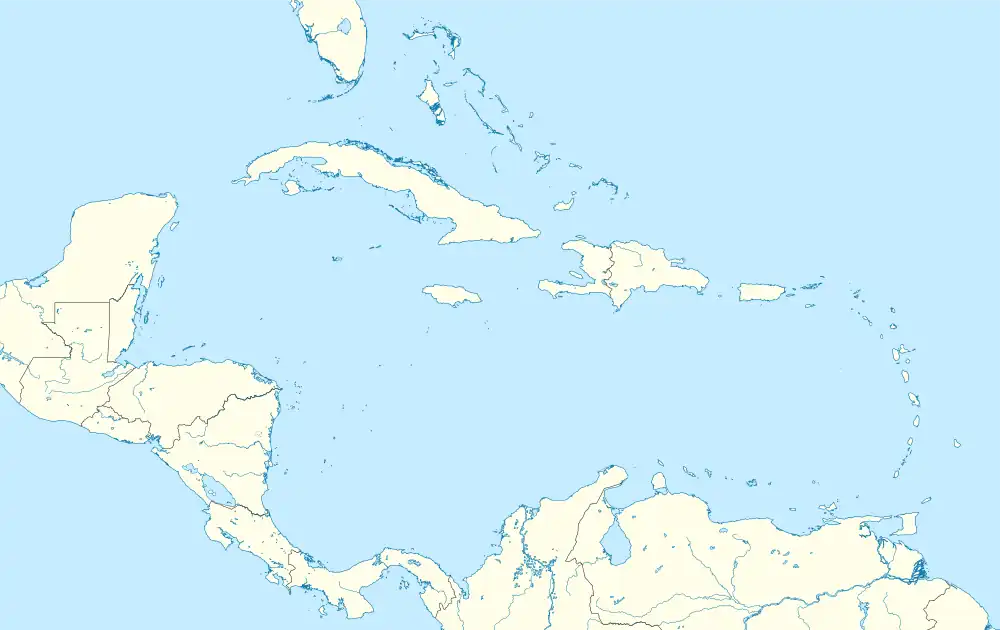Pasto, Morovis, Puerto Rico
Pasto is a barrio in the municipality of Morovis, Puerto Rico. Pasto has about 8 sectors and its population in 2010 was 767.[3][4][5]
Pasto | |
|---|---|
Barrio | |
 View of Pasto | |
 Location of Pasto within the municipality of Morovis shown in red | |
 Pasto Location of Puerto Rico | |
| Coordinates: 18°16′29″N 66°26′03″W[1] | |
| Commonwealth | |
| Municipality | |
| Area | |
| • Total | 3.14 sq mi (8.1 km2) |
| • Land | 3.14 sq mi (8.1 km2) |
| • Water | 0 sq mi (0 km2) |
| Elevation | 1,171 ft (357 m) |
| Population (2010) | |
| • Total | 767 |
| • Density | 244.3/sq mi (94.3/km2) |
| Source: 2010 Census | |
| Time zone | UTC−4 (AST) |
| Zip code | 00687 |
Geography
Pasto is located in the southern part of Morovis, between Vaga and Perchas and to its north are San Lorenzo and Río Grande, all barrios of Morovis. The southern border of Pasto barrio is with the municipality of Orocovis.
History
Morovis and its barrios were founded in 1818 by Juan Evangelista Rivera and Juan José de Torres and a group.
The barrio was in Spain's gazetteers[6] until Puerto Rico was ceded by Spain in the aftermath of the Spanish–American War under the terms of the Treaty of Paris of 1898 and became an unincorporated territory of the United States. In 1899, the United States Department of War conducted a census of Puerto Rico finding that the population of Pasto barrio was 1,314.[7]
| Census | Pop. | Note | %± |
|---|---|---|---|
| 1900 | 1,314 | — | |
| 1910 | 1,137 | −13.5% | |
| 1920 | 1,307 | 15.0% | |
| 1930 | 1,200 | −8.2% | |
| 1940 | 1,245 | 3.8% | |
| 1950 | 823 | −33.9% | |
| 1960 | 596 | −27.6% | |
| 1980 | 704 | — | |
| 1990 | 730 | 3.7% | |
| 2000 | 777 | 6.4% | |
| 2010 | 767 | −1.3% | |
| U.S. Decennial Census 1899 (shown as 1900)[8] 1910-1930[9] 1930-1950[10] 1980-2000[11] 2010[12] | |||
On September 20, 2017 Hurricane Maria devastated the island of Puerto Rico. The landslides caused by Hurricane Maria's rains left Morovis cut off from its neighboring municipalities. In Pasto, a large boulder and landslide blocked entry into and out of the barrio, cutting it off from any outside help. Bridge access into San Lorenzo, a neighboring barrio was cut off as well.[13]
Sectors
Barrios (which are, in contemporary times, roughly comparable to minor civil divisions)[14] in turn are further subdivided into smaller local populated place areas/units called sectores (sectors in English). The types of sectores may vary, from normally sector to urbanización to reparto to barriada to residencial, among others.[15][16][17]
The following sectors are in Pasto barrio:[18]
Sector Culebra, Sector Flamboyán, Sector Galán, Sector Limones, Sector Los Pérez, Sector Orquídeas, Sector Pasto, and Sector Trinchera.
See also
References
- "US Gazetteer 2019". US Census. US Government.
- U.S. Geological Survey Geographic Names Information System: Pasto barrio
- Picó, Rafael; Buitrago de Santiago, Zayda; Berrios, Hector H. Nueva geografía de Puerto Rico: física, económica, y social, por Rafael Picó. Con la colaboración de Zayda Buitrago de Santiago y Héctor H. Berrios. San Juan Editorial Universitaria, Universidad de Puerto Rico,1969.
- Gwillim Law (20 May 2015). Administrative Subdivisions of Countries: A Comprehensive World Reference, 1900 through 1998. McFarland. p. 300. ISBN 978-1-4766-0447-3. Retrieved 25 December 2018.
- Puerto Rico: 2010 Population and Housing Unit Counts.pdf (PDF). U.S. Dept. of Commerce, Economics and Statistics Administration, U.S. Census Bureau. 2010.
- "Anuario del comercio, de la industria, de la magistratura y de la administración. 1881". Biblioteca Nacional de España (in Spanish). p. 1614. Retrieved 4 April 2023.
- Joseph Prentiss Sanger; Henry Gannett; Walter Francis Willcox (1900). Informe sobre el censo de Puerto Rico, 1899, United States. War Dept. Porto Rico Census Office (in Spanish). Imprenta del gobierno. p. 161.
- "Report of the Census of Porto Rico 1899". War Department Office Director Census of Porto Rico. Archived from the original on July 16, 2017. Retrieved September 21, 2017.
- "Table 3-Population of Municipalities: 1930 1920 and 1910" (PDF). United States Census Bureau. Archived (PDF) from the original on August 17, 2017. Retrieved September 21, 2017.
- "Table 4-Area and Population of Municipalities Urban and Rural: 1930 to 1950" (PDF). United States Census Bureau. Archived (PDF) from the original on August 30, 2015. Retrieved September 21, 2014.
- "Table 2 Population and Housing Units: 1960 to 2000" (PDF). United States Census Bureau. Archived (PDF) from the original on July 24, 2017. Retrieved September 21, 2017.
- Puerto Rico: 2010 Population and Housing Unit Counts.pdf (PDF). U.S. Dept. of Commerce Economics and Statistics Administration U.S. Census Bureau. 2010. Archived (PDF) from the original on 2017-02-20. Retrieved 2019-08-02.
- "Graves deslizamientos incomunican a Morovis [Serious landslides cut off Morovis]". El Nuevo Día (in Spanish). 22 September 2017. Retrieved 17 September 2020.
- "US Census Barrio-Pueblo definition". factfinder.com. US Census. Archived from the original on 13 May 2017. Retrieved 5 January 2019.
- "Agencia: Oficina del Coordinador General para el Financiamiento Socioeconómico y la Autogestión (Proposed 2016 Budget)". Puerto Rico Budgets (in Spanish). Retrieved 28 June 2019.
- Rivera Quintero, Marcia (2014), El vuelo de la esperanza: Proyecto de las Comunidades Especiales Puerto Rico, 1997-2004 (first ed.), San Juan, Puerto Rico Fundación Sila M. Calderón, ISBN 978-0-9820806-1-0
- "Leyes del 2001". Lex Juris Puerto Rico (in Spanish). Retrieved 24 June 2020.
- "PRECINTO ELECTORAL MOROVIS 020" (PDF). Comisión Estatal de Elecciones (in Spanish). PR Government. 8 October 2019. Retrieved 24 June 2020.
External links
 Media related to Pasto (Morovis) at Wikimedia Commons
Media related to Pasto (Morovis) at Wikimedia Commons